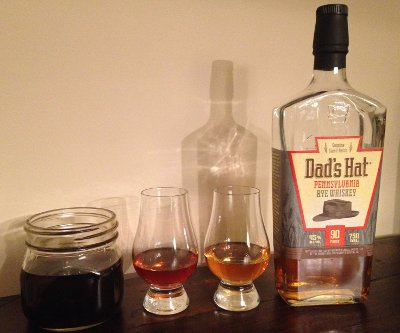For the past couple of years, I've given up beer for Lent and substituted other beverages to make up the shortfall. One of the joys of this, aside from a shrunken waistline, is that I've got whole swaths of new territory to explore, including Bourbon and Rye. While I'm certainly not going to turn down the latest and greatest hyped stuff and have already tackled some of those, I'm also content to work my way through some of the more standard expressions that don't generate a lot of buzz on blogs or social media. This is good, as Pennsylvania is something of a booze wasteland. I mean, sure, I'd love to be reviewing Elijah Craig Barrel Strength instead of the standard 12, but the entire state's allocation sold out in, like 10 minutes (ditto just about every other special release I've ever seen). They're instituting a lottery system this year, but I'm not really counting on that (I'm pretty sure I've already lost my first lottery a few days ago!) and I've got plenty of old standards to work through anyway. Someday, I definitely want to take down more Pappy and BTAC, but for now, let's drink some stuff that I can actually manage to get my hands on (though I should note, half of these were procured in Maryland rather than PA).
Anywho, sometimes it's nice to take a break from obsessing over beer to take a look at other realms of boozy glory, so today we have four reviews compiled over the past few months. I'm a beer nerd with a baby palate, so take the reviews with a grain of salt. I've gotten pretty good at describing beer, but whiskey is still something of an enigma, but I do think I'm getting better.
First up is a Rye Whiskey named after PA Age of Enlightenment man David Rittenhouse, a noted astronomer and clockmaker who went on to become the first director of the United States Mint. Originally distilled in PA, it's now made in Kentucky as a result of the seemingly endless parade of acquisitions and consolidation that happens in the whiskey world. Rittenhouse Rye is part of Heaven Hill's portfolio, but as it turns out, I'm reviewing what is now a highly sought after bottle.
Every distillery has a registered Distilled Spirits Plant (DSP) number, and for whatever reason, Rittenhouse Rye lists the DSP number on their bottles. Back in the 1990s, Rittenhouse was made at Heaven Hill's DSP-KY-31 distillery. Alas, that distillery burned down in a tragic 1996 fire. To make up for the loss in capacity, Heaven Hill contracted with Brown Forman to make Rittenhouse at the DSP-KY-354 distillery. This happens to be the bottle that I'm reviewing today. Just recently, Heaven Hill retook responsibility for distilling this rye at DSP-KY-1 and it looks like they've also done a rebranding. As a result, the old DSP 354 bottles are now highly sought after, especially since the new DSP 1 juice doesn't seem to be as well regarded (though some like it fine, especially considering the price point). Finally, the fact that it takes me 2 years to get through a bottle of whiskey pays off.
One of the reasons I think this took me so long to get through is that, well, it feels a lot like bourbon. I always thought this was just my inexperienced palate talking, but this is apparently one of the "barely legal" ryes, meaning that the mashbill has the minimum required 51% rye (with the rest presumably comprised of corn and a small amount of barley). I've got the Bottled in Bond expression, which is a legal classification meaning it was aged in a federally bonded warehouse and bottled at 100 proof (among other niggling requirements). It's also labeled as Straight, meaning it's at least 4 years old. Let's dive in:
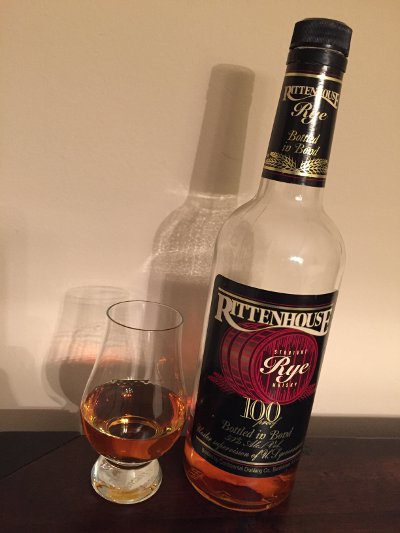
Rittenhouse Rye - D.S.P. KY 354 - Pours a light golden color with moderate legs. Smell has a nice spicebox component to it, a little oak and vanilla kicking in as well, but feels very bourbony (as opposed to distinct rye). Certainly get that rye spice in the taste as well, almost peppery, with some caramel too. Again, though, it has a very bourbony feel. Mouthfeel is medium bodied, a little on the oily side, a little harsh and moderately boozy. Overall, it feels like a pretty standard whiskey, very nice for what it is, works fine neat and it makes good cocktails, but there's nothing here that melts my face either. I'm no rye expert, but this feels more like an extra high rye bourbon than full rye, but maybe that's just my lack of experience coming through. Still, as an all purpose whiskey, it's good, and cheap too. A high B-
Whiskey Nerd Details: 100 Proof, 50% ABV bottled (750 ml). Drank out of a glencairn glass. Distilled at D.S.P. KY 354.
Beer Nerd Musings: The Rittenhouse Rye barrel aged Eclipse stout was my favorite entry from the 2012 vintage, though it did not fare quite as well in the 2014 vintage horizontal tasting. I don't know of any other beers specifically aged in these barrels, but I always wonder if younger barrels make for better beer aging than older ones. As a homerbewer, I see potential for a rye oaked beer here, though I tend to prefer using bourbon (not that I'm that much of an expert in such things).
Next up, we have Sazerac Rye. Named after the cocktail of the same name, this is distilled by Buffalo Trace. They make are two expressions, a 6 year old and an 18 year old (a venerated rye that's part of the fabled Buffalo Trace Antique Collection). What I have here is the younger of the two, affectionately nicknamed "Baby Saz" by those in the know, and like a lot of ryes these days, it's apparently also in shortish supply. I did miss out on it when PA sold their allocation recently (another online flash sale that went in less than an hour), but Kaedrin favorite State Line Liquors in Maryland had some for the taking. This appears to be another "barely legal" rye, but oddly, I found it to be much more distinct from Bourbon, perhaps less spicy, but more subtle. Let's take a closer look:
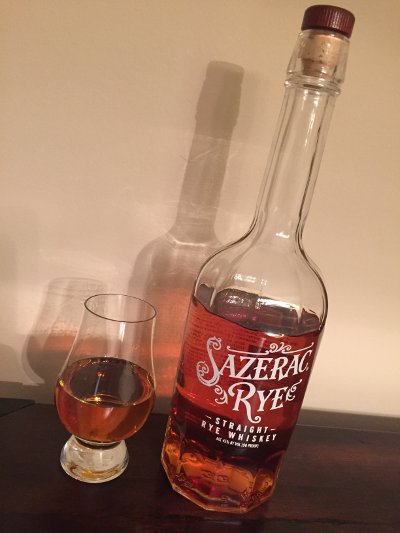
Sazerac Rye - Pours a yellowish orange color with thin legs. Unlike Rittenhouse, this doesn't smell much like bourbon. Definitely a little spice, but an almost fruity note to it (I notice this in high rye beers too), certainly not "new make" but the oak does not tamp down the rye at all, some nice vanilla though. Taste has a lot more of that spicy rye character, not as harsh or boozy as Rittenhouse, though I guess the lower proof will do that to my baby beer palate, a little oaky character pitches in too, but like the nose, it's not overwhelming and what you really get is the rye. Mouthfeel is lighter than the Rittenhouse, more subtle, less oily, with an approachable booziness. Overall, this reminds me of a more mature Dad's Hat Rye in that you really get that rye character coming through, but it's got less of a new make feel to it. I'm sure this is great for cocktails, though I haven't used it for such just yet. B
Whiskey Nerd Details: 90 Proof, 45% ABV bottled (750 ml). Drank out of a glencairn glass.
Beer Nerd Musings: Rye has a reputation for contributing spicy elements to both beer and whiskey, but as mentioned above, I find that some higher rye beers tend to also exhibit a distinct, almost fruity note that I got out of Sazerac too (and not at all from Rittenhouse). Funnily enough, one of the examples I've had of a rye wine that exhibited this fruity twang was a beer aged in Rittenhouse Rye barrels. Go figure. I've never had anything specifically aged in a Sazerac Rye barrel, though there are apparently a few examples out there. To be honest, I don't know how well it would work, as it seems a little too subtle to really impart that great, rich character that a good barrel aged beer displays. If you think I'm full of it, I will gladly submit to your Sazerac Barrel Aged brew to test it out.
Now we transition to Bourbon, but we'll stick with Buffalo Trace and check out their flagship product. It uses their lower rye recipe (also used for Eagle Rare 10, a bourbon I never really took a fancy to, as well as some of the more prized BT products like Stagg) and while it carries no age statement, consensus seems to indicate it's around 8 years old. Pretty basic stuff, but I actually really enjoyed this more than I thought (though clearly not as much as the high rye Elmer T. Lee, which is fantastic).
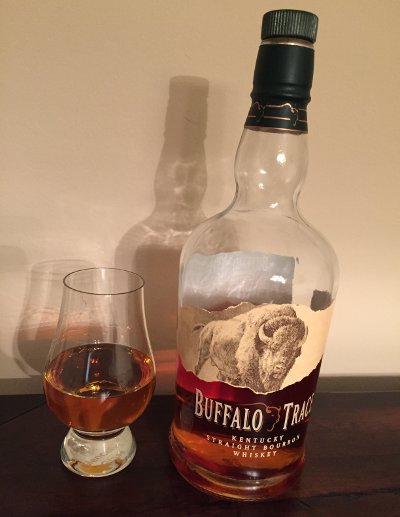
Buffalo Trace - Pours a golden orange color with adorable little legs (i.e. not much). Smells sweet, caramel, toffee, vanilla, leavened with hints of spice. Love the nose on this. Not intense, but it hits the right notes for me. Taste hits the spice a little harder, but the underlying sweetness is still there, a little caramel and vanilla goes a long way. Mouthfeel is soft and approachable, light on the booze (keep in mind by beer palate is unused to this sort of assault, so this is saying something). Overall, this is another all purpose bourbon, great neat and I'm sure it would do fine in cocktails. Would be perfect for bourbon-oaked homebrew. It's not intense or mind-blowing, but it gets the job done. B+
Whiskey Nerd Details: 90 Proof, 45% ABV bottled (750 ml). Drank out of a glencairn glass.
Beer Nerd Musings: The Buffalo Trace Eclipse variant won the blind horizontal tasting I held recently, narrowly beating out Four Roses and Elijah Craig 12 (each of which had a single outlier that dragged them down). Local brewery Neshaminy Creek got in a whole boatload of Buffalo Trace barrels last year and aged a few beers that I've had in them, to varying degrees of success (I think any issues I have with them come down to the base beer). Not so local, but close enough Voodoo brewery made a few imperial stouts aged in BT barrels, one of which was fantastic and the other of which didn't work quite as well. Again, not sure if that's the fault of the barrels so much as the base beer, but make of that what you will. I'd still consider using this for bourbon oaked homebrew, and might actually use the remainder of this bottle for a Scotch ale I've been dreaming up (though, uh, perhaps I should use a Scotch for that, eh?)
Finally, the oldest and probably most well regarded whiskey in this post, we've got Elijah Craig 12. Named after the Rev. Elijah Craig, one of a few historical figures that are dubiously credited with inventing Bourbon, we're back with Heaven Hill now, and this one's pretty darned good. Apparently, they recently changed the label to omit the 12 year old age statement. Though the age statement still appears on the back label, many believe this is a precursor to a reduced or genuine NAS release in the nearish future, so stock up I guess. As you can see from my bottle, I rather enjoyed this and finished the whole thing within a year of purchasing.
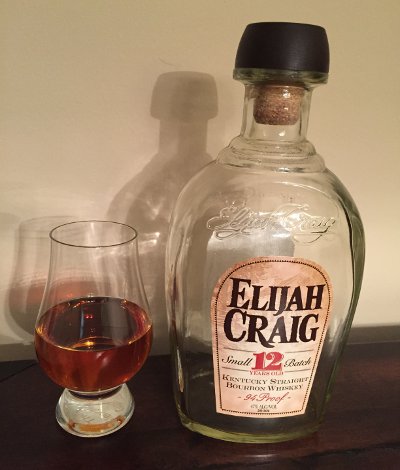
Elijah Craig 12 - Pours a dark orange color, almost brown, medium legs. Smells very spicy and oaky, big spicebox component here, hints of caramel, vanilla, maybe some maple character. Taste follows the nose, big spice component, cinnamon, red pepper, cocoa, tons of toasted oak, caramel, maple sugar. Mouthfeel is almost full bodied, spicy, kinda dry, not super boozy. It kinda reminds me of a better Orphan Barrel bourbon (at about a third of the price), oaky, but not overly so, such that it doesn't overpower other flavors. Overall, this is fantastic, great oak and spice character with a sweet maple backbone, a solid choice for an everyday Bourbon. This would also be perfect for a bourbon oaked homebrew, if I didn't just finish the bottle. A high B+
Whiskey Nerd Details: 94 Proof, 47% ABV bottled (750 ml). Drank out of a glencairn glass.
Beer Nerd Musings: EC12 is a highly prized barrel for brewers. It's well known that Goose Island's Bourbon County Brand Stout (and some variants) uses these (though their barrel program is so huge today that I wouldn't be surprised if they used barrels from every major producer). As mentioned above, the EC12 variant of Eclipse fared very well in the horizontal tasting and is generally one of the more prized variants (the 18 year variant they did a few years ago also has a spectacular reputation). This, too, would be great fodder for homebrew. It's rich and intense character at a relatively low proof should impart a lot of flavor (I'd go stout with this one).
Phew, that was a lot. This is obviously a beer blog, so it may be a while, but I've got some interesting stuff coming my way (or sitting in my cabinet waiting to be opened), so I will try to check in with a Bourbon review every now and again, just to break things up. I've got a couple of Private Selections, including a Four Roses barrel selected by a bunch of beer nerds, and another State Line Liquors private selection of Wild Turkey. I'd say stay tuned, but it might be a while, but hang in there.
